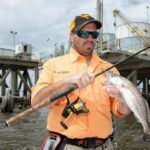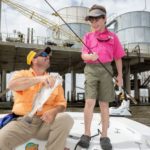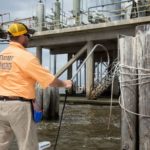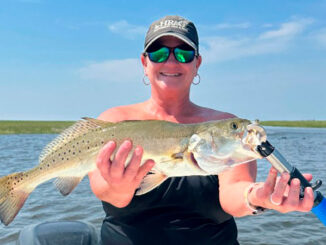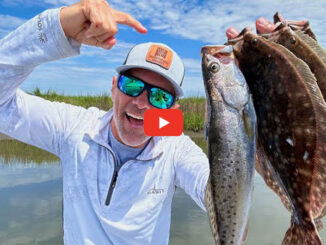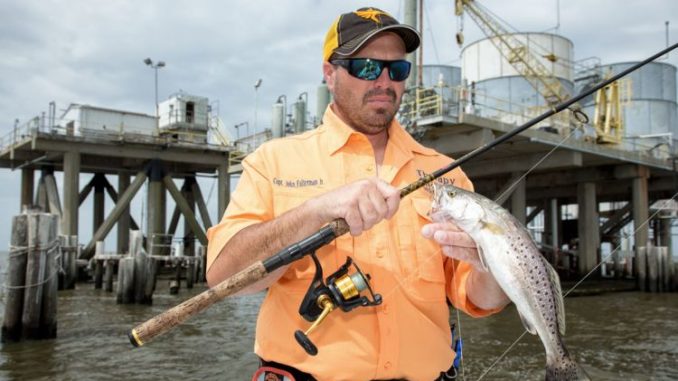
Take on the trout this summer on their turf: shallow rigs
Dorothy was right; there is no place like home.
Whether it’s the love of your own family, the feel of your own furniture, or the comfort of your own commode, home is the place to be if you like the security that comes with the familiar.
At my home, I’m familiar with what kind of food is in the fridge. I’m familiar with where the coldest air comes out of the vents. And I’m familiar with the best places to hide so nobody can bother me.
When it comes to the peace of mind that familiar surroundings provide, speckled trout aren’t all that much different from us. They like to congregate around spots where they have all they need in one little confined area.
If home is truly where the heart is, speckled trout must be head over heels in love with shallow rigs.
In one little confined area, trout have everything they need to survive… assuming Capt. John Falterman doesn’t cross paths with them.
Falterman, who owns and operates Therapy Charters out of Rigolets Marina in Slidell, loves fishing the shallow rigs in Lake Borgne during June.
Like plenty of other shallow-water rigs across the coast of Louisiana, the rigs in Lake Borgne provide everything speckled trout need in order to make them a perfect spot for trout to call them home.
“These shallow rigs are their own ecosystems,” Falterman told me as we idled away from Rigolets Marina. “They have all kinds of stuff on them — barnacles, algae… whatever — that attracts bait. That bait then attracts the trout. It just doesn’t get any better for speckled trout fishing during the summer.”
Falterman brought his 24-foot Sportsman bay boat off plane near the first rig in Lake Borgne just on the east side of the CSX bridge and got started. The water looked muddy on the surface, but that didn’t deter him from doing a quick scan with his Humminbird unit.
“Looks like there are some fish here,” he said as he began handing out spinning rods and reels rigged with live shrimp. “We’ll give them about 10 minutes then go hit another rig if they don’t bite.”
One of the characteristics of these shallow rigs that trout find most appealing is the shell pads that can typically be found underneath them.
“Those shell beds usually hold a lot of fish,” Falterman said. “I think they’re so good because the shrimp can’t bury themselves in the mud, so they kind of bounce off those shells. The fish just sit there working them over. But as good as a shell pad can be, the best spot tends to be the edge of the shell and the hard mud bottom. It’s the perfect ambush spot for trout.”
I asked Falterman why we were fishing a rig that was sitting in such muddy water. He explained that salt water is denser than fresh water, so as bad as it looked at the surface, it could have been perfectly clear down where the fish were.
“Clarity is important,” he said, “but with the rivers around here it’s not unusual to have nasty water on top but really clean underneath. That’s why I tell people to not give up on a rig because of dirty water. Instead, give up on it because you eliminated it because you didn’t get any bites.”
Not getting any bites wasn’t an issue at our first rig. Trout readily gobbled up our live shrimp that were kicking around 18 inches off the bottom. It was kind of a no-brainer once Falterman figured out where the fish were gathered.
Because trout could be any number of places surrounding a shallow-water rig, Falterman took us through his typical method of operation when first approaching and fishing a rig.
“I tell everybody to pull up to a rig and have people kind of fan cast all around the boat,” he said. “I’ll generally have one throw toward the rig, one throw out the side, and one throw out the back. We’ll work around like this and try to eliminate dead water. Once we figure them out, then I can position the boat so everybody can reach them.”
Had we not caught any, Falterman said we would have begun to kind of stick and move around all the rigs in Lake Borgne.
“There are probably close to two dozen rigs in Borgne, so we’ve got a lot to try,” he went on. “On any given day, some will be more productive than others. “You’ve got some closer to Shell Beach, some over by Biloxi Marsh, and some scattered toward the north. So if I don’t get bit in 10 or 15 minutes, there’s no sense dying on one rig.”
Falterman usually starts his initial search for fish around a rig by moving to the down-current side. Although he admits he never knows exactly where they’re going to hold, the down-current side has the benefit of allowing to get out of the current in the eddies behind the pilings and other obstructions.
“They’re not going to eat a hamburger on a treadmill,” Falterman quipped. “Instead, they’re going to get out of the current so they don’t have to work so hard for their food. They like to tuck into little spots where the current isn’t as strong then dart out and grab a bite as it washes by.”
Although he sometimes finds stragglers out away from the thickest concentration of fish, Falterman knows that whatever reason one fish is in a particular spot is often a good enough reason for several more to be there.
“It could be the rig itself,” he said. “It could be the shell pad right under the rig. It could even be an old left-over shell pile from a neighboring rig that is no longer there. That’s why you’ve got to work them close in and far out because you just never know. And those shell pads can create enough of a current break that trout can tuck in behind them then dart up as bait washes over.”
Falterman had both of us and our two sons fishing live shrimp on a drop-shot rig. It was easy enough to make a long cast then drag the heavy weight on bottom. When a trout bit, we just kind of held our lines tight until they loaded up then start pulling up and reeling at the same time.
Although a Carolina rig is a tried-and-true technique for fishing around rigs, Falterman prefers the drop-shot because he can control how far off the bottom they can fish his shrimp.
“I take about a 42-inch leader of 30-pound test Berkley Big Game line and double it over,” he explained as he showed me how to make a drop-shot rig. “I tie a 1-ounce weight to one end and a treble hook to the other. I fold the line over in half and tie an overhand knot to make a small loop. Then I just tie my braided line to that loop.”
When this rig hits bottom, the heavy weight sits still while the shrimp floats down current from it. Falterman keeps his rod tip low if he wants to keep his shrimp near the bottom, but he raises it up if he wants the shrimp up off the bottom.
“You can look at the fish to see where you ought to be holding it,” he said. “If they’ve got a lot of red marks and scrapes on their bellies, keep it near the bottom because they’re hugging it. If not you can lift it up a little bit. Of course there’s nothing saying a fish on bottom won’t dart up 18 inches to grab it, so the best thing to do is experiment until you figure out what they want.”
In open water like Lake Borgne, shallow rigs provide the perfect environment for speckled trout to find everything they need to survive.
Whether they’re looking for food or shelter, speckled trout know there’s no place better to hang their hats this summer.
